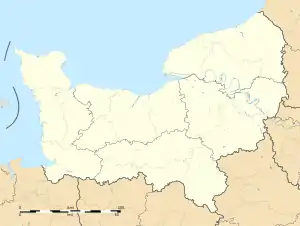Fontaine-le-Dun | |
|---|---|
.jpg.webp) The centre of Fontaine-le-Dun | |
 Coat of arms | |
Location of Fontaine-le-Dun | |
 Fontaine-le-Dun  Fontaine-le-Dun | |
| Coordinates: 49°48′50″N 0°51′03″E / 49.8139°N 0.8508°E | |
| Country | France |
| Region | Normandy |
| Department | Seine-Maritime |
| Arrondissement | Dieppe |
| Canton | Saint-Valery-en-Caux |
| Intercommunality | CC Côte d'Albâtre |
| Government | |
| • Mayor (2020–2026) | Philippe Etienne[1] |
| Area 1 | 5.35 km2 (2.07 sq mi) |
| Population | 885 |
| • Density | 170/km2 (430/sq mi) |
| Time zone | UTC+01:00 (CET) |
| • Summer (DST) | UTC+02:00 (CEST) |
| INSEE/Postal code | 76272 /76740 |
| Elevation | 44–100 m (144–328 ft) (avg. 60 m or 200 ft) |
| 1 French Land Register data, which excludes lakes, ponds, glaciers > 1 km2 (0.386 sq mi or 247 acres) and river estuaries. | |
Fontaine-le-Dun (French pronunciation: [fɔ̃tɛn lə dœ̃]) is a commune in the Seine-Maritime department in the Normandy region in northern France.
Geography
Fontaine-le-Dun is a small farming town, with associated light industry, situated by the banks of the river Dun in the Pays de Caux, some 15 miles (24 km) southwest of Dieppe, at the junction of the D142 and the D79 roads.
Heraldry
 Arms of Fontaine-le-Dun |
The arms of Fontaine-le-Dun are blazoned : Azure, a sword between 2 crescents argent above both a lance head Or, and on a chief gules, a cross argent.
|
Population
| Year | Pop. | ±% p.a. |
|---|---|---|
| 1968 | 607 | — |
| 1975 | 641 | +0.78% |
| 1982 | 796 | +3.14% |
| 1990 | 962 | +2.40% |
| 1999 | 978 | +0.18% |
| 2007 | 947 | −0.40% |
| 2012 | 838 | −2.42% |
| 2017 | 903 | +1.51% |
| Source: INSEE[3] | ||
Places of interest
- The eleventh-century church of Notre-Dame
- A sixteenth-century stone cross
- A manorhouse dating from the seventeenth century
Notable people
Pierre Giffard, journalist, was born here in 1853.
See also
References
- ↑ "Répertoire national des élus: les maires" (in French). data.gouv.fr, Plateforme ouverte des données publiques françaises. 13 September 2022.
- ↑ "Populations légales 2021". The National Institute of Statistics and Economic Studies. 28 December 2023.
- ↑ Population en historique depuis 1968, INSEE
External links
Wikimedia Commons has media related to Fontaine-le-Dun.
- An unofficial website (in French)
This article is issued from Wikipedia. The text is licensed under Creative Commons - Attribution - Sharealike. Additional terms may apply for the media files.